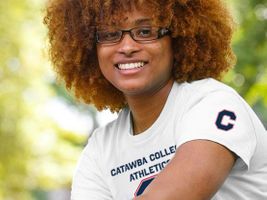Catawba College Mathematics Professor Joyce Caddell said she plugged a hole in her knowledge this summer when she visited Mexico’s Yucatan Peninsula to study the numerology of the ancient Mayas. Caddell was among 35 educators from across the U.S. who participated in a faculty development program offered by the National Science Foundation (NSF).
According to Caddell, she learned that the ancient Mayas of Mexico and Central America were the most advanced mathematicians in the New World. In pre-Columbian Americas, they were the only culture to create the concept of "zero," a concept necessary for engaging in higher mathematics. Their numeration system, she said, had only three symbols, used base 20 instead of base 10 as we do, and was written vertically, beginning at the bottom."
The Mayas were also adept, she said, at using mathematics and astronomy to predict astronomicalEvents with their complex and accurate calendar system. Many of the buildings at their religious sites were so positioned to capitalize on the occurrence of various equinox and solsticeEvents.
Perhaps most intriguing to Caddell’s group was the Mayas’ ability to use geometry and the concept of proportions in their building techniques. To study this recently discovered Mayan phenomenon, the educators traveled to various ruins, taking measurements of different architectural features and helping to confirm for themselves the whole theory of Mayan geometry.
"This new slant on Mayan sacred geometry has to do with their proportionality," Caddell explained. "When we took measurements of various rectangular objects – door frames and rooms for example - we saw the same proportionalities being used at different sites all over the peninsula. It made you wonder what there was about the Mayas’ understanding of these relationships that made them use the ratios over and over.
"How did they measure? How did they know how to do it? The repetitive nature was what I found so fascinating."
Caddell also puzzled over the Mayas need to shock and awe with their religious sites. The enormous sites were laboriously constructed of limestone cubes by people who had to quarry and ferry these cubes to the building sites without the aid of beasts of burden, such as elephants or oxen. Images of jaguars and serpents were used to decorate wall panels. And, incorporating their knowledge of astronomy and astronomicalEvents, the Mayan rulers could have used on-cue sunrises, or eclipses striking in a particular place on their buildings to affirm their potency as leaders.
"This was a very observant people," she explained. "They noticed the sun, the moon and the stars, and the movements of the celestial bodies. They built their ceremonial pyramids in relation to their observations."
This ancient people was also very violent, Caddell said, and put "enormous effort into ceremony, with human sacrifices playing an integral part of it." On their legendary ballfields, she noted, participants played to win, because winning meant they would continue to live, while the losers were punished with death by decapitation.
Also prevalent at the ancient sites were sacred cenotes, she described as "pristine looking pools or bodies of water." But, she noted, archaeologists have discovered the remains of human sacrifices at the bottom of these, again revealing the very dark side of the Mayas. And, she wondered if their violent nature could have been part of their undoing, since the religious sites were abandoned long before the arrival of the Spanish conquistadors.
In marked contrast to their violent ancestors, the Mayan people who live in the Yucatan Peninsula today, are "a pleasure to be around – kindly and soft-spoken," Caddell said. When her group visited a multigenerational family on their homestead, they found them living a very simple and happy life.
"The grandfather was scraping sisal to make a rope or a hammock, while the grandmother was sitting on the dirt making and cooking tortillas over an open fire. She was using a piece of tin balanced on two sticks over the fire and with her bare hands, shaping, then turning the tortillas. She offered one to Caddell who accepted and ate it with relish. "They lived simple lives and although they had to work hard, they seemed so content and happy," Caddell explained.
She said she came away from her Yucatan learning experience with a better understanding of the Meso-American peoples, but with more questions than she had answers. Additionally, she came away with "pride that I was able to survive" the strenuous walking and climbing in the hot, humid climate.
Caddell, who joined Catawba’s mathematics department in 1988, is already making plans to share her new-found knowledge with several groups, including a class of graduate- level elementary education students studying numeration, and a modern mathematics class concerning proportion and symmetry.
